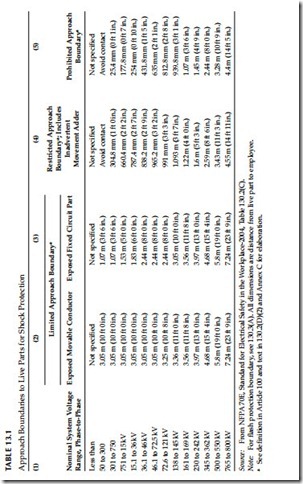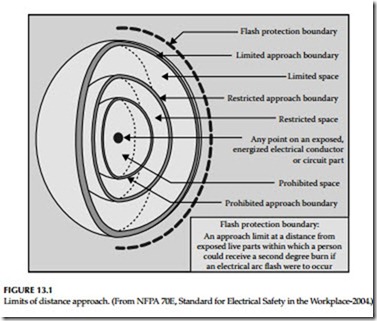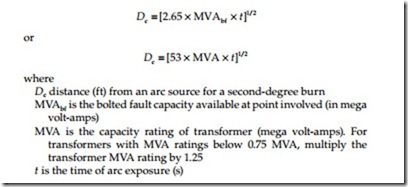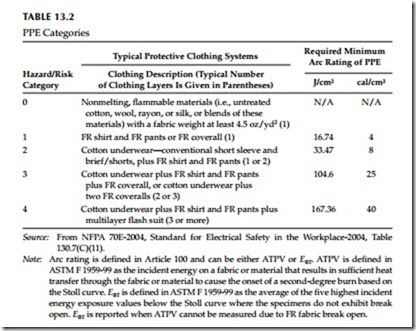Industry Standards and Regulatory Requirements for Safety
ANSI C2: The National Electrical Safety Code-2007
The National Electrical Safety Code (NESC) is intended to provide practical rules for safeguarding personnel during the installation, operation, or maintenance of electrical supply and communications lines and associated equipment. The NESC rules cover supply and communications lines, equipment, and associated work practices used by both private and public electrical companies (utilities). The NESC covers five major areas as listed below.
• Grounding methods for electrical supply and communications facilities
• Rules for installation and maintenance of electrical supply stations and equipment
• Safety rules for the installation and maintenance of overhead electrical supply and communications lines
• Safety rules for the installation and maintenance of underground electric supply and communications lines
• Rules for the operation of electric supply and communications lines and equipment
Section 410, “General requirements” of NESC-2007 contains information and guidance on electric safety requirements that are necessary for safeguarding employees in the workplace. In accordance with Section 410 the employer is required to inform the employees on safety rules, safety training and arc hazard evaluation including wearing of arc-rated clothing. These requirements as stated in NESC-2007 standard are as follows:
1. The employer shall inform each employee working on or about communications equipment or electric supply equipment and the associated lines, of the safety rules governing the employee’s con- duct while so engaged. When deemed necessary, the employer shall provide a copy of such rules.
2. The employer shall provide training to all employees who work in the vicinity of exposed energized facilities. The training shall include applicable work rules required by this part and other mandatory referenced standards or rules. The employer shall ensure that each employee has demonstrated proficiency in required tasks. The employer shall provide retraining for any employee who, as a result of routine observance of work practices, is not following work rules.
3. Effective as of January 1, 2009, the employer shall ensure that an assessment is performed to determine potential exposure to an
electric arc for employees who work on or near energized parts or equipment. If the assessment determines a potential employee exposure greater than 2 cal/cm2 exists, the employer shall require employees to wear clothing or a clothing system that has an effec- tive arc rating not less than the anticipated level of arc energy. When exposed to an electric arc or flame, clothing made from the following materials shall not be worn: acetate, nylon, polyester, or poly- propylene. The effective arc rating of clothing or a clothing system to be worn at voltages 1000 V and above shall be determined using Tables 410-1 and 410-2 or performing an arc hazard analysis. When an arc hazard analysis is performed, it shall include a calculation of the estimated arc energy based on the available fault current, the duration of the arc (cycles), and the distance from the arc to the employee.
Exception 1: If the clothing required by this rule has the potential to create additional and greater hazards than the possible exposure to the heat energy of the electric arc, then clothing with an arc rating or arc thermal performance value (ATPV) less than that required by the rule can be worn.
Exception 2: For secondary systems below 1000 V, applicable work rules required by this part and engineering controls shall be uti- lized to limit exposure. In lieu of performing an arc hazard analysis, clothing or a clothing system with a minimum effec- tive arc rating of 4 cal/cm2 shall be required to limit the likeli- hood of ignition.
Note 1: A clothing system (multiple layers) that includes an outer layer of flame-resistant (FR) material and an inner layer of non-FR material has been shown to block more heat than a single layer. The effect of the combination of these multiple layers can be referred to as the effective arc rating.
Note 2: It is recognized that arc energy levels can be excessive with second- ary systems. Applicable work rules required by this part and engi- neering controls should be utilized.
ANSI/National Fire Protection Association (NFPA) 70, National Electrical Code (NEC)-2008
The NEC NFPA 70 is part of the NFPA codes. The NEC includes information on design, installation and other technical information of electrical facilities and its principle objective is to help minimize the possibility of electric fires. The NEC or portions of it are adopted as local law in many municipalities, cities, states, and other such areas. Since 2002, the NEC, article 110-16 requires
flash hazard labels on electrical equipment to warn personnel of the potential electric arc-flash hazards and the personal protective equipment (PPE) they must wear when working on energized equipment. The NEC article 110-16 is listed below for reader’s reference.
110.16—flash protection: Electrical equipment, such as switchboards, panel- boards, industrial control panels, meter socket enclosures, and motor control centers, that are in other than dwelling occupancies, and are likely to require examination, adjustment, servicing, or maintenance while energized shall be field marked to warn qualified persons of potential electric arc-flash hazards. The marking shall be located so as to be clearly visible to qualified persons before examination, adjustment, servicing, or maintenance of the equipment.
FPN No. 1: NFPA 70E, Standard for Electrical Safety in the Workplace-2004, provides assistance in determining severity of potential expo- sure, planning safe work practices, and selecting PPE.
FPN No. 2: ANSI Z535.4-1998, Product Safety Signs and Labels, provides guidelines for the design of safety signs and labels for applica- tion to products.
ANSI/NFPA 70B, Standard for Electrical Equipment Maintenance-2006
The electrical equipment maintenance is a publication of the NFPA and it contains recommended practice information on maintenance of electric equipment and apparatus. The 70B document covers systems and equipment which are typically installed in industrial plants, commercial buildings, and large family dwellings.
ANSI/NFPA 70E, Standard for Electrical Safety in the Workplace-2004
The electrical safety requirement in workplaces is a publication of NFPA. This code contains information and guidance on electric safety requirements that are necessary for safeguarding employees in the workplace. The sixth edition, published in 2004, reflects several significant changes to the older versions of 70E. The major changes emphasize safe work practices. Clarity and usability of the document are also enhanced. The name of the document was changed to NFPA 70E, Standard for Electrical Safety in the Workplace. The existing Parts 1 through 4 were renamed as Chapters 1 through 4 and are reorganized as follows:
Chapter 1 Safety-related work practices
Chapter 2 Safety-related maintenance requirements Chapter 3 Safety requirements for special equipment Chapter 4 Installation safety requirements
This standard is compatible with corresponding provisions of the NEC, but is not intended to, nor can it, be used in lieu of the NEC. Chapter 4 of NFPA 70E is intended to serve a very specific need of OSHA and is in no way intended to be used as a substitute for the NEC. NFPA 70E is intended for use by employers, employees, and OSHA.
The chapter on safety-related work practices was reorganized to empha- size working on live parts as the last alternative work practice. Therefore it contains extensive requirements for working on or near electrical conductors or circuit parts that have not been put into an electrically safe work condition. When such work is to be performed, the required electrical hazard analysis has specific requirements for the analysis of shock and flash hazards. Other sections of the 70E provide guidance on selecting the proper PPE. The significant requirements for the analysis of shock and flash hazards are as follows:
The NFPA 70E, Article 110.8 (B) (1) Electrical hazard analysis: If the live parts operating at 50 V or more are not placed in an electrically safe work condition, other safety-related work practices shall be used to protect employees who might be exposed to the electrical hazards involved. Such work practices shall protect each employee from arc flash and from contact with live parts operating at 50 V or more directly with any part of the body or indirectly through some other conductive object. Work practices that are used shall be suitable for the conditions under which the work is to be performed and for the voltage level of the live parts. Appropriate safety-related work practices shall be determined before any person approaches exposed live parts within the limited approach boundary by using both shock hazard analysis and flash hazard analysis.
(a) Shock hazard analysis. A shock hazard analysis shall determine the volt- age to which personnel will be exposed, boundary requirements, and the PPE necessary in order to minimize the possibility of electrical shock to personnel. (b) Flash hazard analysis. A flash hazard analysis shall be done in order to protect personnel from the possibility of being injured by an arc flash. The analysis shall determine the flash protection boundary and the PPE that people within the flash protection boundary shall use.
The NFPA 70E, Article 130.2 Approach boundaries to live parts:
A. Shock hazard analysis: A shock hazard analysis shall determine the voltage to which personnel will be exposed, boundary requirements, and the PPE necessary in order to minimize the possibility of electric shock to personnel.
B. Shock protection boundaries: The shock protection boundaries identified as limited, restricted, and prohibited approach boundaries are applicable to the situation in which approaching personnel are exposed to live parts.
C. Approach to exposed live parts operating at 50 V or more: No qualified person shall approach or take any conductive object closer to
exposed live parts operating at 50 V or more than the restricted approach boundary set forth in Table 130.2(C), unless any of the following apply:
1. The qualified person is insulated or guarded from the live parts operating at 50 V or more (insulating gloves or insulating gloves and sleeves are considered insulation only with regard to the energized parts upon which work is being performed), and no part of the qualified person’s body crosses the prohibited approach boundary set forth in Table 130.2(C) which is shown in Table 13.1.
2. The live part operating at 50 V or more is insulated from the qualified person and from any other conductive object at a different potential.
3. The qualified person is insulated from any other conductive object as during live-line bare-hand work.
D. Approach by unqualified persons: Unqualified persons shall not be permitted to enter spaces that are required under 400.16(A) to be accessible to qualified employees only, unless the electric conductors and equipment involved are in an electrically safe work condition.
1. Working at or close to the limited approach boundary: Where one or more unqualified persons are working at or close to the limited approach boundary, the designated person in charge of the work space where the electrical hazard exists shall cooperate with the designated person in charge of the unqualified person(s) to ensure that all work can be done safely. This shall include advising the unqualified person(s) of the electrical hazard and warning him or her to stay outside of the Limited Approach Boundary.
2. Entering the limited approach boundary: Where there is a need for an unqualified person(s) to cross the limited approach boundary, a qualified person shall advise him or her of the possible hazards and continuously escort the unqualified person(s) while inside the limited approach boundary. Under no circumstance shall the escorted unqualified person(s) be permitted to cross the restricted approach boundary.
The requirements stated in NFPA 70E for shock protection and safe distances for qualified and unqualified personnel can be summarized as follows:
Flash protection boundary: An approach limit at a distance from exposed live parts within which a person could receive a second-degree burn if an electric arc flash were to occur. Appropriate flash-flame protection equipment must be utilized for persons entering the flash protection region. This distance may be outside or inside the following shock protection distances.
a See definition in Article 100 and text in 130.2(D)(2) and Annex C for elaboration.
Limited approach boundary: An approach limit at a distance from an exposed live part within which a shock hazard exists. A person crossing the limited approach boundary and entering the limited region must be qualified to perform the job/task.
Restricted approach boundary: An approach limit at a distance from an exposed live part within which there is an increased risk of shock, due to electrical arc over combined with inadvertent movement, for personnel working in close proximity to the live part. The person crossing the restricted approach boundary and entering the restricted space must have a documented work plan approved by authorized management, use PPE that is appropriate for the work being per- formed and is rated for voltage and energy level involved.
Prohibited approach boundary: An approach limit at a distance from an exposed live part within which work is considered the same as making contact with the live part. The person entering the prohibited space must have specified training to work on energized conductors or live parts. Any tools used in the prohibited space must be rated for direct contact at the voltage and energy level involved. The limits of approach are depicted in Figure 13.1.
The NFPA 70E, Article 130.3 Flash-hazard analysis: A flash hazard analysis shall be done in order to protect personnel from the possibility of being injured by an arc flash. The analysis shall
determine the flash protection boundary and the PPE that people within the flash protection boundary shall use.
Flash protection boundary: For systems that are 600 V or less, the flash protection boundary shall be 4.0 ft, based on the product of clearing times of six cycles (0.1 s) and the available bolted fault current of 50 kA or any combination not exceeding 300 kA cycles (5000 A s). For clearing times and bolted fault currents other than 300 kA cycles, or under engineering supervision, the flash protection boundary shall alternatively be permitted to be calculated in accordance with the following general formula:
At voltage levels above 600 V, the flash protection boundary is the distance at which the incident energy equals 5 J/cm2(1.2 cal/cm2). For situations where fault clearing time is 0.1 s (or faster), the flash protection boundary is the distance at which the incident energy level equals 6.24 J/cm2(1.5 cal/cm2).
Protective clothing and PPE for application with a flash hazard analysis: Where it has been determined that work will be performed within the flash protection boundary by NFPA 70E, Article 130.3(A), the flash hazard analysis shall determine, and the employer shall document, the incident energy exposure of the worker (cal/cm2). The incident energy exposure level shall be based on the working distance of the employee’s face and chest areas from a prospective arc source for the specific task to be performed. FR clothing and PPE shall be used by the employee based on the incident energy exposure associated with the specific task. Recognizing that incident energy increases as the distance from the arc flash decreases, additional PPE shall be used for any parts of the body that are closer than the distance at which the incident energy was determined. As an alternative, the PPE requirements of NFPA 70E, Article 130.7(C)(9)(a) shall be permitted to be used in lieu of the detailed flash hazard analysis approach described in NFPA 70E, Article 130.3(A).
The NFPA 70E, Article 130.7 (13), Arc flash protective equipment: All arc-rated PPE include the ATPV with units in cal/cm2. The required
PPE at specific locations is determined by comparing the calculated incident energy to the ratings for specific combinations of PPE. NFPA 70E, Table 130.7(C)(11) lists examples of protective clothing systems and typical characteristics including the degree of protection for various clothing. The protective clothing selected for the correspond- ing hazard/risk category number shall have an arc rating of at least the value listed in the last column of NFPA 70E, Table 130.7(C)(11). The NFPA 70E, Table 130.7(C)(11) is shown in Table 13.2 below.
For actual applications, the calculated incident energy must be com- pared to specific PPE combinations used at the facility being evaluated. The exception to this is the upper limit of 40 cal/cm2. While PPE is available in ATPV values of 100 cal/cm2 or more, values above 40 cal/cm2 are prohibited due to the sound, pressure, and concussive forces. The sound, pressure, and concussive forces are more severe than the thermal values of arc energy greater than 40 cal/cm2. An examination of the categories listed in Table 13.2 implies that each category has range (spread) of arc rating, i.e., for example category 1 range is 4–7.999, category 2 range is 8–24.999, and so on. It should be noted that manufacturers are allowed to label their garments for a given PPE category as long as garment’s thermal value falls within the cat- egory’s range. For example, a garment with an 8 cal/cm2 rating can be labeled category 2 even though the category 2 can go up to 24.99 cal.
It is inappropriate for some manufacturers to promote their safety equipment using lower calorie values for a given category of PPE. Therefore, when selecting PPE, the actual calculated incident energy at the specific work location must be compared to specific garment thermal rating within the given category to correctly protect the worker from a flash hazard.
The NFPA 70E, Article 400.11, Flash Protection: Switchboards, panelboards, industrial control panels, and motor control centers in other than dwelling occupancies and are likely to require examination, adjustment, servicing, or maintenance while energized shall be field marked to warn qualified persons of potential electric arc-flash hazards. The marking shall be located so as to be clearly visible to qualified persons before examination, adjustment, servicing, or maintenance of the equipment. This is the same requirement stated in Article 110-16 of the NEC-2002.
Occupational Safety and Health Administration (OSHA) Standards
OSHA standards are federal regulations and apply to all covered industries except those states which have adopted safety programs which are approved by the OSHA. A partial listing of industries covered by OSHA is General Industry, Construction Industry, Power Generation, Transmission and Distribution, and Telecommunications. OSHA safety standards are published in the Code of Federal Regulations, Title 29, Subtitle B, Chapter XVII. The OSHA electrical safety standards are in at least four categories similar to the four chapters of NFPA 70E.
These are
• Design and installation safety
• Safety-related work practices
• Safety-related maintenance requirements
• Special equipment
Electrical safety standards for general industry are found in Part 1910, Subpart S, I, and J. A partial listing of subpart S and I is given below.
them, unless the employer can demonstrate that de-energizing introduces additional or increased hazards or is infeasible due to design or operational limitations. When employees are required to work where there is a potential electrical hazard, part 1910.335 calls for the employer to provide electrical pro- tective equipment that is appropriate for the specific parts of the body to be protected and for the work to be performed.
Employers are responsible for performing a hazard assessment in accor- dance with part 1910.132(d)(1) (i–iii). The requirements are as follows:
1910.132(d)(1): The employer shall assess the workplace to determine if hazards are present, or are likely to be present, which necessitate the use of PPE. If such hazards are present, likely to be present, the employer shall:
1910.132(d)(1)(i): Select, and have each affected employee use, the types of PPE that will protect the affected employee from the hazards identified in the hazard assessment
1910.132(d)(1)(ii): Communicate selection decisions to each affected employee
1910.132(d)(1)(iii): Select PPE that properly fits each affected employee. The employer shall verify that the required workplace hazard assess-
ment has been performed through a written certification that iden-
tifies the workplace evaluated; the person certifying that the
evaluation has been performed; the date(s) of the hazard assess-
ment; and, which identifies the document as a certification of hazard
assessment.
1910.335(a)(1)(i) PPE: Employees working in areas where there are potential electrical hazards shall be provided with, and shall use, elec- trical protective equipment that is appropriate for the specific parts of the body to be protected and for the work to be performed.
1910.132(f) Training: The employer shall provide training to each employee who is required by this section to use PPE. Each such employee shall be trained to know at least the following: (1) When PPE is necessary; (2) What PPE is necessary; (3) How to properly don, doff, adjust, and wear PPE; (4) The limitations of the PPE; and (5) The proper care, maintenance, useful life, and disposal of the PPE.
Each affected employee shall demonstrate an understanding of the training specified in paragraph (f)(1) of this section, and the ability to use PPE properly, before being allowed to perform work requiring the use of PPE.
1910.132(f)(3) Proficiency and Retraining: When the employer has reason to believe that any affected employee who has already been trained, but does not have the understanding and skill required by para- graph (f)(2) of this section, the employer shall retrain each such employee. Circumstances where retraining is required include, but are not limited to, situations where: changes in the workplace render
previous training obsolete; or changes in the types of PPE to be used render previous training obsolete; or inadequacies in an affected employee’s knowledge or use of assigned PPE indicate that the employee has not retained the requisite understanding or skill. The employer shall verify that each affected employee has received and understood the required training through a written certification that contains the name of each employee trained, the date(s) of training, and that identifies the subject of the certification.




